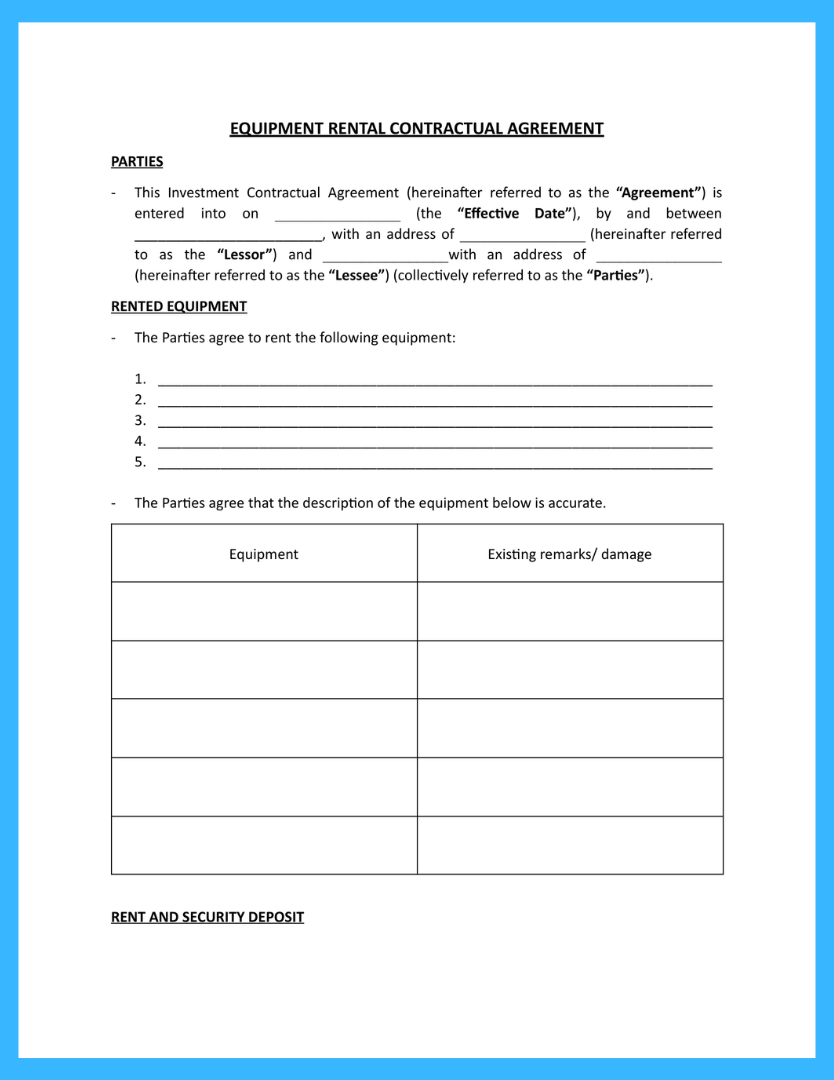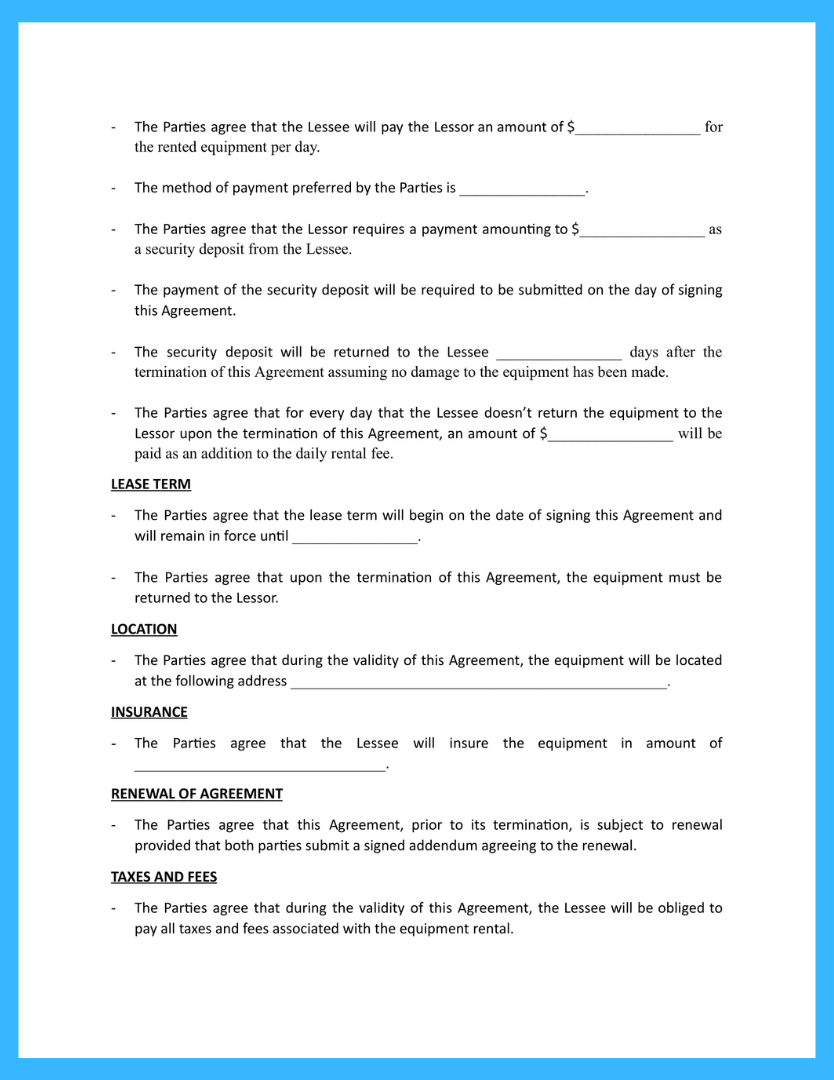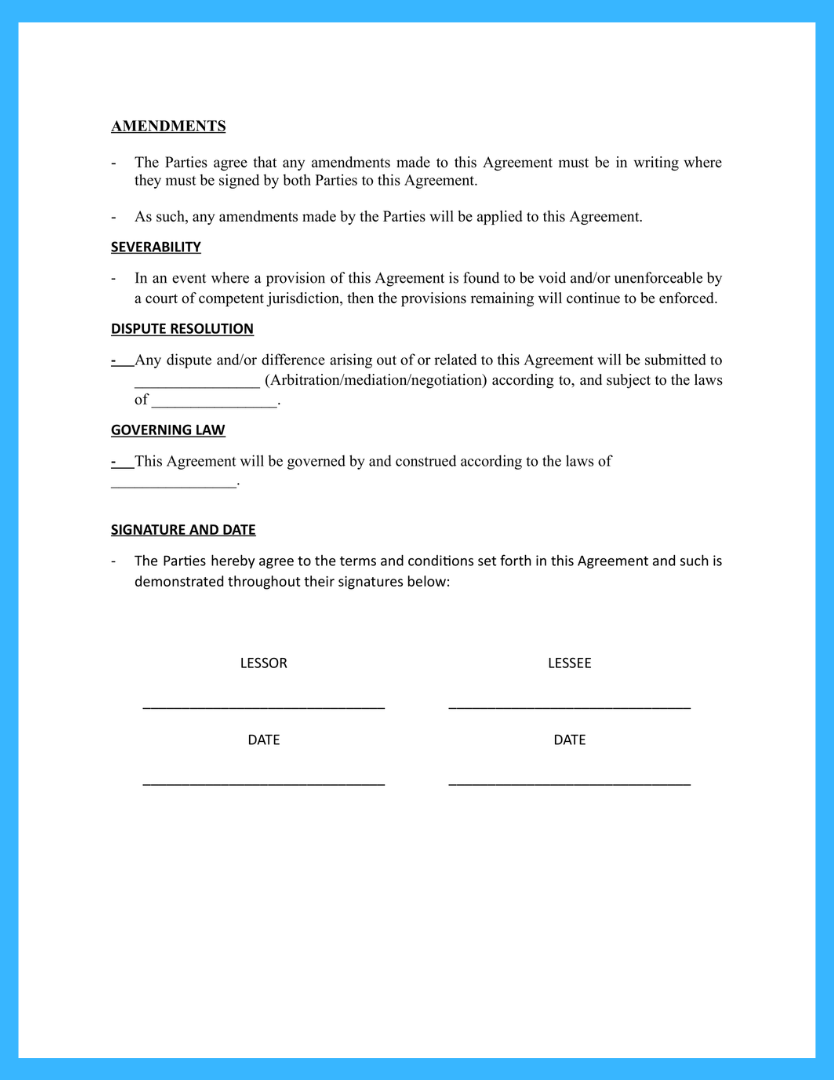Free Equipment Rental Agreement Template
Finding the right equipment for your business is a significant achievement. After all, it can act as the backbone of your business value proposition. However, how do you ensure the equipment leasing process is seamless?
Welcome to the comprehensive guide to an equipment rental agreement. This article explores its nuances, types, and best practices for drafting a foolproof equipment lease agreement.



What is an Equipment Rental Agreement?
An equipment rental agreement, also known as an equipment lease agreement, is a formal contract between the owner of the equipment (the lessor) and the entity seeking to rent the equipment (the lessee). This lease agreement defines the terms and conditions under which the equipment is rented, safeguarding the rights and obligations of both parties.
The agreement encompasses critical details like the duration of the lease, rental payment, security deposit, maintenance responsibilities, and insurance requirements. The equipment could be anything from construction machinery, medical apparatus, kitchen equipment, or IT hardware.
This legally binding rental equipment agreement form ensures clarity between the parties involved, minimizing potential disputes. It’s an essential tool for conducting business, especially in markets where leasing equipment is more cost-effective than purchasing it outright.
Types of Equipment Rental Agreements
Equipment rental agreements vary depending on the industry and the type of equipment being leased. For instance, businesses may lease cranes, excavators, or bulldozers in the construction industry. Restaurants might rent commercial ovens, refrigerators, or espresso machines, while healthcare facilities often lease sophisticated medical equipment like MRI machines or ultrasound devices.
Two primary types of equipment lease agreements include the standard equipment lease and the lease-to-own deal. The standard lease enables businesses to rent equipment for a specified duration, after which the equipment is returned. This model is ideal for companies needing equipment for temporary projects or wanting to avoid the cost of owning, maintaining, and updating the equipment.
On the other hand, a lease-to-own agreement allows the lessee to purchase the equipment at the end of the lease term. This type of agreement can be attractive for businesses looking to acquire equipment without the hefty upfront costs.
DISCLAIMER: We are not lawyers or a law firm and we do not provide legal, business or tax advice. We recommend you consult a lawyer or other appropriate professional before using any templates or agreements from this website.
When to Use an Equipment Rental Agreement Template
The time to use an equipment rental agreement template is when a lessor and a lessee decide to initiate a rental transaction. These templates offer a structured format that covers all essential aspects of an agreement, ensuring nothing critical is overlooked.
However, there may be instances when you might not need this type of agreement. For example, a simple invoice might suffice if the equipment is of low value or the rental duration is short.
Yet, the benefits of an equipment rental agreement are many. It clearly outlines the rental terms and conditions, defines both parties’ roles and responsibilities, and reduces potential disagreements. An equipment rental contract can also protect the lessor’s ownership rights and the lessee’s rights to use the equipment within the agreed parameters.
Ultimately, it brings clarity, transparency, and a sense of security to the rental process. This makes lease agreements a core component of your business operations.
Download our Equipment Rental Agreement Template
The implications of not using a equipment rental agreement can be catastrophic. That’s why we’ve created a simple template to help you to protect your business.
What to Include in an Equipment Rental Agreement
Before crafting an effective rental agreement for your rented piece(s) of equipment(s), there are several key components you need to consider comprehensively on how you want contract terms defined. Doing so minimizes confusion while ensuring transparency in your dealings with either party– fostering smooth communication and a successful transaction.
Personal Information
The initial segment of your equipment rental agreement should be brimming with information about the lessor (the party lending the equipment) and the lessee (the party using the equipment). Enlist all relevant identifiers, including names, contact details, and addresses.
Maintaining the accuracy and currency of this information is paramount for seamless communication between both parties. Including such data arms the contract with validity and provides a valuable reference in case disputes arise or negotiations become necessary.
Equipment Details
When renting equipment, it’s critical to provide a clear and detailed description of the equipment. Make sure to encompass all vital details, including the type of equipment, its make and model, serial number, condition, and any distinctive characteristics.
Detailed equipment information dispels potential confusion and ensures the lessee is well-informed about exactly what they are renting. Remember to include information about the equipment’s intended use for added clarity.
It is crucial to accurately document the equipment condition at the beginning of the rental period. A comprehensive equipment evaluation can help avoid unwarranted claims of damage to the equipment owner and protect the lessee from liability for pre-existing issues.
Rental Term
The rental term needs to be defined with a high degree of accuracy. It should incorporate the start and end dates of the lease and lay out what ensues at the lease’s end. Clearly indicate whether the equipment should be returned or if there’s a provision for a lease extension.
Also, provide a detailed outline of the renewal process — whether it’s automatic, the period within which non-renewal should be indicated, and how modifications to terms (like price alterations) will be managed upon renewal. A well-articulated rental period can help avert misunderstandings and ensure both parties are on the same page regarding all terms and conditions.
Rental Cost, Deposit, & Fees
The agreement should spell out the rental costs, including how much will be paid, when payments are due, and acceptable payment methods. The lessor should also disclose any additional fees, such as late fees for overdue payments, penalties for damages, or costs for extended rental periods.
Security deposits are commonly required as part of equipment rental agreements. This section should outline the deposit amount, the terms for its return, and conditions under which part or all of the deposit may be withheld (such as damage to the equipment or breach of contract).
Equipment Delivery
When leasing equipment, it’s crucial to specify the delivery and return process in your agreement. Designate who will handle transport, the location, and the timing for pickup and return.
Clearly define which party bears the cost and risk associated with transportation, such as damages during transit. By ironing out these details, you guarantee a seamless equipment handover experience.
Maintenance
Proper maintenance of leased equipment is fundamental to its longevity. Outline whether the lessor or lessee will take on regular servicing, repairs, and inspections in your agreement. Detail the required frequency and associated costs of maintenance. If the lessee is responsible, lay out agreed-upon maintenance standards, excluding regular wear and tear, and consequences for failure to comply.
Insurance & Taxes
Often overlooked, your equipment rental agreement should explicitly state the responsibility for insurance and taxes. Determine which party must insure the rented equipment, the necessary coverage level, and who bears the cost of the premiums.
Additionally, clarify who is accountable for any taxes associated with the rental, such as local or federal taxes or property and sales taxes. Ensure compliance with local regulations by consulting with a professional or conducting research.
Remember, insurance and tax obligations can vary based on local laws and the type of equipment being rented. So, consulting with a professional or doing thorough research is wise.
Terms & Conditions
This section outlines the full scope of the rights and responsibilities of each party. Terms and conditions can cover everything from equipment use restrictions to indemnification clauses to default and termination conditions.
The terms should also include a dispute resolution clause outlining how disagreements relating to the agreement will be resolved. Generally, including a clause mandating mediation or arbitration is most cost-effective and efficient before resorting to litigation.
While using generic terms and conditions might be tempting, remember that a rental agreement is most effective when tailored to your specific needs and situation. Be as detailed and straightforward as possible to avoid any misinterpretation.
Signatures
Finally, no agreement is complete without the signatures of all parties involved. In the age of digital transactions, more businesses are moving towards electronic signatures for convenience, speed, and security. A platform like Signaturely can facilitate this process, offering a secure and legally binding method to sign off on your equipment rental agreement.
Remember, both parties should receive a fully signed copy of the agreement for their records. This final, signed document serves as proof of the contract and can be indispensable if disputes arise later.
How to Write an Equipment Rental Agreement
Creating an effective equipment rental agreement requires careful planning from start to finish. Begin with a comprehensive template to provide a solid foundation for your document. Make sure you do not overlook vital elements involved when creating agreements from scratch. Once you have chosen one, input pertinent information such as parties involved, equipment information, and costs as specifically outlined in previous sections.
Afterward, tailor aspects of the template according to your personal or business needs, particularly if you have special requirements like maintenance descriptions concerning specialized equipment rentals. Also, check each section thoroughly before proceeding with finalizing the document.
Once drafted,it is equally important that you review procedures carefully to ensure fair solutions that are beneficial on both sides. If desired, seek counsel from legal professionals before submitting for signature.
Leverage advanced technologies like e-signature solutions offered by Signaturely, simplifying signature processes and their reliability usage ensuring next-generation security technologies facilitating prompt delivery while mainlining legality -boosting efficiency and trust for the recipient.
Download our Equipment Rental Agreement Template
The implications of not using a equipment rental agreement can be catastrophic. That’s why we’ve created a simple template to help you to protect your business.
FAQs About Equipment Rental Agreements
Below are some of the common questions people have about equipment rental agreements.
Equipment leasing is a process where one party (the lessor) provides equipment for use to another party (the lessee) for a specified period in exchange for periodic payments.
Equipment leases are typically structured with the parties’ details, equipment description, rental terms, payment details, maintenance responsibilities, insurance and tax obligations, and other terms and conditions.
Equipment rentals can be categorized based on the type of equipment, the industry it’s used in, and the lease terms (short-term, long-term, lease-to-own).
The accounting for leased equipment depends on the lease type. For an operating lease, lease payments are usually considered an operating expense. The leased equipment might be recorded as an asset and a liability on the lessee’s balance sheet for a capital lease.
Not all equipment leases are operating leases. Whether a lease is an operating lease or a capital lease (finance lease) depends on specific criteria. If the lease transfers ownership of the equipment to the lessee or covers most of the equipment’s life or value, it might be considered a capital lease.
What You Need to Remember About an Equipment Rental
At its core, an equipment rental agreement is a safety net, a guiding document for your rental journey. Always ensure it’s comprehensive, fair, and clear, covering all necessary details.
Remember, solutions like Signaturely can simplify the equipment rental contract process, making securing that required signature and peace of mind all the more accessible.
Equipment Rental Agreement Template
EQUIPMENT RENTAL CONTRACTUAL AGREEMENT
PARTIES
- This Investment Contractual Agreement (hereinafter referred to as the “Agreement”) is entered into on ________________ (the “Effective Date”), by and between ________________________, with an address of ________________ (hereinafter referred to as the “Lessor”) and ________________with an address of ________________ (hereinafter referred to as the “Lessee”) (collectively referred to as the “Parties”).
RENTED EQUIPMENT
The Parties agree to rent the following equipment:
- __________________________________________________________
- __________________________________________________________
- __________________________________________________________
- __________________________________________________________
- __________________________________________________________
- The Parties agree that the description of the equipment below is accurate.
Equipment |
|
RENT AND SECURITY DEPOSIT
- The Parties agree that the Lessee will pay the Lessor an amount of $________________ for the rented equipment per day.
- The method of payment preferred by the Parties is ________________.
- The Parties agree that the Lessor requires a payment amounting to $________________ as a security deposit from the Lessee.
- The payment of the security deposit will be required to be submitted on the day of signing this Agreement.
- The security deposit will be returned to the Lessee ________________ days after the termination of this Agreement assuming no damage to the equipment has been made.
- The Parties agree that for every day that the Lessee doesn’t return the equipment to the Lessor upon the termination of this Agreement, an amount of $________________ will be paid as an addition to the daily rental fee.
LEASE TERM
- The Parties agree that the lease term will begin on the date of signing this Agreement and will remain in force until ________________.
- The Parties agree that upon the termination of this Agreement, the equipment must be returned to the Lessor.
LOCATION
- The Parties agree that during the validity of this Agreement, the equipment will be located at the following address ________________________________________________.
INSURANCE
- The Parties agree that the Lessee will insure the equipment in amount of ________________________________.
RENEWAL OF AGREEMENT
- The Parties agree that this Agreement, prior to its termination, is subject to renewal provided that both parties submit a signed addendum agreeing to the renewal.
TAXES AND FEES
- The Parties agree that during the validity of this Agreement, the Lessee will be obliged to pay all taxes and fees associated with the equipment rental.
AMENDMENTS
- The Parties agree that any amendments made to this Agreement must be in writing where they must be signed by both Parties to this Agreement.
- As such, any amendments made by the Parties will be applied to this Agreement.
SEVERABILITY
- In an event where a provision of this Agreement is found to be void and/or unenforceable by a court of competent jurisdiction, then the provisions remaining will continue to be enforced.
DISPUTE RESOLUTION
- Any dispute and/or difference arising out of or related to this Agreement will be submitted to ________________ (Arbitration/mediation/negotiation) according to, and subject to the laws of ________________.
GOVERNING LAW
- This Agreement will be governed by and construed according to the laws of ________________.
SIGNATURE AND DATE
- The Parties hereby agree to the terms and conditions set forth in this Agreement and such is demonstrated throughout their signatures below:
LESSOR |
LESSEE _______________________________ |
DATE
_______________________________ |
DATE
_______________________________ |
Related Proposals and Templates
Download our Equipment Rental Agreement Template
The implications of not using a equipment rental agreement can be catastrophic. That’s why we’ve created a simple template to help you to protect your business.